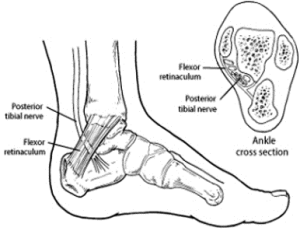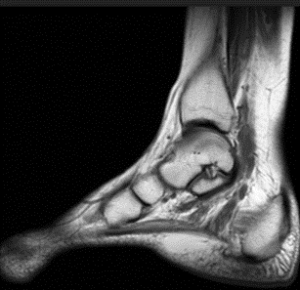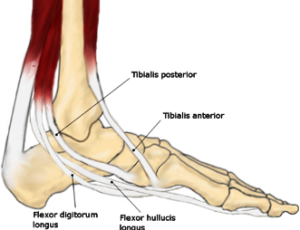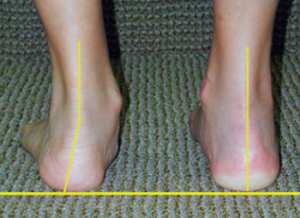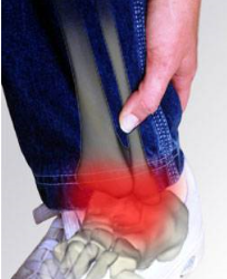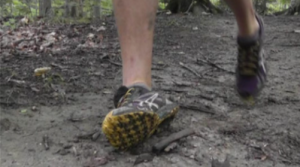Tarsal Tunnel Syndrome
The tarsal tunnel is the narrow space formed on the inside of the ankle (medial malleolus) and a thick ligament (flexor retinaculum) that protects and maintains the structures contained within the tunnel (arteries, veins, tendons and nerve). Tarsal tunnel syndrome is caused by a compression or squeezing on the posterior tibial nerve producing symptoms of from the ankle into the foot.
Patients with tarsal tunnel syndrome commonly report a tingling and burning sensation in the foot and ankle. Numbness and a ‘shooting pain’ into the foot is also often reported. Some additional symptoms associated with tarsal tunnel syndrome include;
- pain often felt at the inside of the foot and ankle
- pain can be isolated or even radiate up into the calf
- symptoms may be exacerbated by standing for long periods of time
- symptoms may be exacerbated by excessive exercising (walking, running) or starting of a new exercise program
Some causes of tarsal tunnel syndrome include;
- Flat feet (over pronation) – people with flat feet are at risk for developing tarsel tunnel syndrome as the outward tilting of foot causing compression and irritation of the tibial nerve.
- Any swelling in the area causing compression of the nerve – ankle sprain, trauma,
- Space occupying lesions such as ganglions, bony spurs or cysts that can compress the nerve
Treatment
A comprehensive podiatric assessment is recommended to prevent the progression of symptoms and ensure appropriate treatment is undertaken. Diagnostic imaging including a X-ray, Ultrasound and often a MRI may be required for further diagnosis.
A variety of treatment options, often used in combination are available to treat tarsal tunnel syndrome. At Sydney Foot Clinic the treatment options offered include;
- Rest and Ice – keeping off the foot and reducing activity prevents further injury and encourages healing. Ice can reduce inflammation, swelling and symptoms.
- Non-steroidal anti-inflammatory medication – help reduce the pain and inflammation
- Supportive footwear
- Custom made orthotic therapy – orthotics may be prescribed to address any biomechanical factors such as over pronation (flat feet) reducing pressure on the tibial nerve.
- Immobilization – restricting movement in a brace or cast is sometime necessary to reduce symptoms and reduce pressure on the tibial nerve
- Injection therapy – Injections of a local anaesthetic provide pain relief, and an injected corticosteroid may be useful in treating the inflammation.
Proper evaluation and diagnosis is important as the symptoms of tarsal tunnel syndrome can get confused with other conditions. It is important to seek early treatment for of tarsal tunnel syndrome as the symptoms can cause permeant nerve damage if left untreated. Surgical treatment of tarsal tunnel syndrome is sometimes required when there is no response to conservative management.
Posterior Tibial Tendon Dysfunction
The posterior tibial tendon serves as one of the major supporting structures of arch, helping the foot to function while walking. Posterior tibial tendon dysfunction (PTTD) is a condition caused by degenerative changes in the tendon, impairing its ability to support the arch. This weakening and changes to the tendon results in flattening of the foot.
PTTD is sometimes also referred to as ‘adult acquired flatfoot’ because it is the most common type of flatfoot developed during adulthood. Although this condition typically occurs in only one foot, it may develop in both feet. PTTD is usually progressive, and can get worse over time if not treated early.
Causes
Overuse of the posterior tibial tendon is often the cause of PTTD. In fact, the symptoms usually occur after activities that involve the tendon, such as running, walking, hiking, or climbing stairs.
Symptoms
Symptoms of PTTD may include pain, swelling, flattening (drop) of the arch and an inward rolling of the ankle. As PPTD becomes more advanced, the arch flattens out even more and the pain often shifts to the outside of the foot. The tendon usually has deteriorated considerably and arthritis often develops in the foot and in severe cases in the ankle.
Treatment
The progressive nature of PTTD calls for early diagnosis of the disorder and early treatment for effective treatment. If treated early enough, your symptoms may resolve without the need for surgery and the progression of deterioration can be stopped.
PTTD is usually treated non-surgically and at Sydney Foot Clinic the treatment options offered include;
- Custom orthotic therapy – orthotics worn in the shoe are prescribed by the podiatrist to give the required arch support.
- Bracing – an ankle brace or support may be given by the podiatrist to support the foot and ankle
- Immobilization – Sometimes a short-leg cast or boot is worn to immobilize the foot and allow the tendon to heal, or you may need to completely avoid all weight-bearing for a short period of time
- Medications – Non-steroidal anti-inflammatory drugs (NSAIDS) help reduce pain and inflammation
- Footwear – supportive footwear is recommend to support the foot and footwear modifications may be performed to achieve further support
Sinus tarsi syndrome
 Sinus Tarsi Syndrome is a clinical disorder characterised by specific symptoms localized to the sinus tarsi. The sinus tarsi (“eye of the foot”) is a small cavity on the outside of the foot formed between the ankle (talus) and heel (calcaneus).
Sinus Tarsi Syndrome is a clinical disorder characterised by specific symptoms localized to the sinus tarsi. The sinus tarsi (“eye of the foot”) is a small cavity on the outside of the foot formed between the ankle (talus) and heel (calcaneus).
A neurovascular structure, tenderness and pain can be felt at the sinus tarsi. Sinus Tarsi Syndrome most commonly occurs in the following patients;
- Flat feet – over pronation
- Ankle sprains – acute or chronic trauma (repetitive ankle sprains) can result to damage of ligaments and structures within the sinus tarsi causing pain
Patients with Sinus tarsi syndrome present with localized pain in the sinus tarsi region aggravated by weight bearing activities (walking, running, jogging). Palpation by a podiatrist on the sinus tarsi will reciprocate pain and pain is usually increased when activity is performed on uneven surfaces (sand).
After a diagnosis is established conservative treatment can be initiated which is generally effective in eliminating the symptoms and problem. At Sydney Foot Clinic the treatment options offered may include;
- Rest and Ice – keeping off the foot and reducing activity prevents further injury and encourages healing. Ice can reduce inflammation, swelling and symptoms.
- Non-steroidal anti-inflammatory medication – help reduce the pain and inflammation
- Supportive footwear
- Custom made orthotic therapy – orthotics may be prescribed to address any biomechanical factors such as over pronation (flat feet)
- Immobilization – restricting movement in a brace or cast is sometime necessary to reduce symptoms and stress on the sinus tarsi
- Injection therapy – Injections of a local anaesthetic provide pain relief, and an injected corticosteroid may be useful in treating the inflammation.
Ankle Sprain/Instability
An ankle sprain is an injury to one or more ligaments in the ankle, usually on the outside of the ankle. Ligaments are bands of tissue – like rubber bands – that connect one bone to another and bind the joints together. In the ankle joint, ligaments provide stability by limiting excessive movement.
The ankle sprain is the most common atheletic injury. Almost 85% of ankle sprains occur (laterally) on the lateral or outside part of the ankle. Ankle sprains are commonly graded into 3 grades;
- Grade I mild: slight stretching an some damage to fibres of the ligament.
- Grade II moderate: partial tearing of the ligament. Swelling ,bruising and joint instability present
- Grade III severe: complete tear/rupture of the ligament. Severe swelling, bruising and Inability to weight bear without severe pain
Symptoms of ankle sprains
- Ankle pain – mild to severe
- Swelling and bruising
- Difficulty walking or putting weight on the ankle
- Inability to move the ankle
- Weakness and instability in the ankle
Risk factors for ankle sprains
- History (previous) of ankle sprains
- Walking, running or playing on uneven surfaces
- Hypermobility, supinated (high arch) foot type
- Wearing shoes that don’t fit well or don’t have good support
- Playing sports that require a sudden change in direction – jumping and landing awkwardly from a jump or side step (football, soccer, basketball)
- Muscle weakness, poor proprioception and poor previous ankle rehabilitation
Diagnosis
Evaluating ankle injuries, the podiatrist will obtain a comprehensive history of symptoms and examine the foot/ankle. Diagnostic imaging including an X-ray and Ultrasound may be prescribed by the podiatrist to review the extent of the damage to the ankle ligaments. In severe cases, an MRI may be needed to rule out other problems in the ankle such as damage to the articular joint cartilage.
An early assessment and accurate diagnosis is critical to;
- Avoid an chronic ankle instability – leading to repeated ankle sprains
- Early rehabilitation – if delayed it can lead to poor healing and a chance of reinjuring the ankle joint
Treatment
Early treatment of ankle sprains is essential to develop an affective treatment program. At Sydney Foot Clinic the treatment options offered include;
- Rest and Ice – 20 min every two to three hours advised in the first 48-72 hours of the injury taking place
- Keeping off the foot and reducing activity prevents further injury
- Non-steroidal anti-inflammatory medication – help reduce the pain and inflammation
- Exercise program – rehabilitation and strengthening of the ankle to prevent ankle instability, ensure return of range of motion and prevent re-injury
- Custom made orthotic therapy – orthotics may be prescribed to address any biomechanical for risk factors that may lead to recurrence of injury
- Surgery is not required in the vast majority of ankle sprain injuries
Ankle impingement
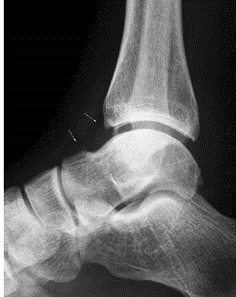 Pinching of tissues in the front of the ankle is called anterior impingement. Athletes who have had several mild ankle sprains or one severe sprain are most likely to have anterior impingement. This is especially related for those athletes who repeatedly bend the ankle upward (dorsiflexion). Irritation along the front edge of the ankle can lead to impingement.
Pinching of tissues in the front of the ankle is called anterior impingement. Athletes who have had several mild ankle sprains or one severe sprain are most likely to have anterior impingement. This is especially related for those athletes who repeatedly bend the ankle upward (dorsiflexion). Irritation along the front edge of the ankle can lead to impingement.
A similar problem can happen after an ankle sprain. As the torn or ruptured ligament heals, the body responds by forming too much scar tissue along the front and side of the ankle joint. Dorsiflexing (upward bend) the ankle can trap the tissue between the edge of the ankle joint, causing pain, popping, and a feeling that the ankle will give out and not support your body weight.
Over time, damage from past ankle sprains may also lead to the formation of small projections of bone called bone spurs. Bone spurs can form along the bottom ledge of the tibia bone or on the upper surface of the talus. As the ankle hinges into dorsiflexion, the bone spurs may begin to jab into the soft tissues along the front edge of the ankle joint, causing symptoms of anterior impingement.
Anterior ankle impingement may feel like ankle pain that continues long after an ankle sprain. The ankle may feel weak, like it can’t be trusted to hold steady during routine activities. When anterior impingement comes from ligament irritation, pain and tissue thickening are usually felt in front and slightly to the side of the ankle. This is the area of the anterior talo fibular ligament. The pain worsens as the foot is forced upward into dorsiflexion. If the ligaments have irritated the synovium of the ankle joint capsule, throbbing pain and swelling from inflammation (synovitis) may also be felt in this area.

